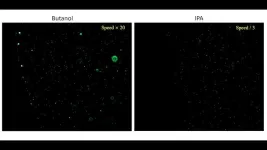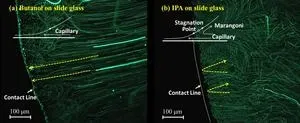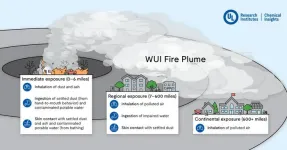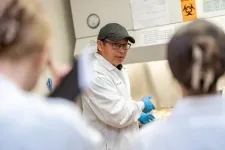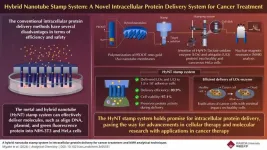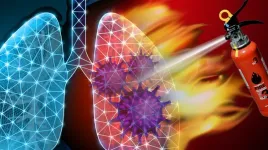(Press-News.org)
Fukuoka, Japan—From the rain drops rolling down your window, to the fluid running across a COVID rapid test, we cannot go a day without observing the world of fluid dynamics. Naturally, how liquids traverse across, and through, surfaces are a heavily researched subject, where new discoveries can have profound effects in the fields of energy conversion technology, electronics cooling, biosensors, and micro-/nano-fabrications.
Now, using mathematical modeling and experimentation, researchers from Kyushu University’s Faculty of Engineering have expanded on a fundamental principle in fluid dynamics. Their new findings may lead to more efficient product development in many liquid-based industries such as high-end electronics manufacturing and lab-on-a-chip disease diagnosis.
“We are living in an ever-present world of liquid and flow,” explains Assistant Professor Zhenying Wang, the first author of the study that was published in the Journal of Fluid Dynamics. “Over the decades, scientist have made efforts to mathematically describe the seemingly simple phenomena of liquid flow and spreading. For example, Tanner’s law describes how a droplet of water spreads on a solid surface over time.”
However, these equations remain incomplete. Even the classic Tanner’s law is only valid for non-volatile liquids like oil. The law becomes less reliable when it comes to volatile liquids like water, alcohol, and perfumes due to the thermodynamics between the air, liquid, and surface coming into play.
“Therefore, we looked into the current laws in hopes of expanding our understanding of the dynamics of volatile liquids,” continues Wang. “We began by mathematically introducing parameters that reflect how volatile liquids react under similar conditions when Tanner’s law was derived.”
The team—in collaboration with Prashant Valluri of the University of Edinburgh and George Karapetsas of Aristotle University of Thessaloniki—then conducted a series of experiments carefully imaging the movement and thermodynamics of volatile liquids. These two approaches allowed the researchers scale up the established fluid dynamic principles and put together a more diverse picture of the physics of volatile liquids interacting with a surface and the air.
“The work here depicts a vast range of real cases and draws a more complete picture of liquid dynamics that could not be explained simply by Tanner’s law,” explains co-author of the paper Associate Professor Chihiro Inoue. “At a more practical level, these results could play a significant role in various liquid-based industries, for example in the cooling of electronics and other energy devices. The world of fluid dynamics can be very meticulous, but careful examination of it is required if we hope to decipher the fundamental flows around us.”
###
For more information about this research, see "Role of Volatility and Thermal Properties in Droplet Spreading: A Generalization to Tanner’s Law," Zhenying Wang, George Karapetsas, Prashant Valluri, and Chihiro Inoue Journal of Fluid Mechanics, https://doi.org/10.1017/jfm.2024.385
About Kyushu University
Founded in 1911, Kyushu University is one of Japan's leading research-oriented institutes of higher education, consistently ranking as one of the top ten Japanese universities in the Times Higher Education World University Rankings and the QS World Rankings. The university is one of the seven national universities in Japan, located in Fukuoka, on the island of Kyushu—the most southwestern of Japan’s four main islands with a population and land size slightly larger than Belgium. Kyushu U’s multiple campuses—home to around 19,000 students and 8000 faculty and staff—are located around Fukuoka City, a coastal metropolis that is frequently ranked among the world's most livable cities and historically known as Japan's gateway to Asia. Through its VISION 2030, Kyushu U will “drive social change with integrative knowledge.” By fusing the spectrum of knowledge, from the humanities and arts to engineering and medical sciences, Kyushu U will strengthen its research in the key areas of decarbonization, medicine and health, and environment and food, to tackle society’s most pressing issues.
END
ATLANTA - Chemical Insights Research Institute (CIRI) of UL Research Institutes applies cutting edge technologies to evaluate the toxicity of burn-impacted land areas affected by the August 2023 Lahaina wildfires. Created with CIRI research partners from Duke University and the East-West Center (EWC) in Hawai’i, the study known as Lahaina Environmental Assessment Project (LEAP), will collect and analyze residual dust, soil and ash samples from properties affected by the fires. These residues, including fine dust, ...
PLYMOUTH MEETING, PA [May 20, 2024] — The National Comprehensive Cancer Network® (NCCN®) today announced publication of new NCCN Guidelines for Patients®: Small Bowel Adenocarcinoma. This free resource for people facing cancer and caregivers is focused on a rare cancer type that typically occurs in the small intestine, where routine screening is impossible, even for high-risk individuals. The small amount of patient information that exists for this cancer type tends to combine it with other cancers of the small intestine (such as sarcomas, neuroendocrine tumors, or lymphomas) despite very different treatment approaches and results.
The NCCN Guidelines for Patients: ...
Groundbreaking research has provided new insight into the tectonic plate shifts that create some of the Earth’s largest earthquakes and tsunamis.
“This is the first study to employ coastal geology to reconstruct the rupture history of the splay fault system,” said Jessica DePaolis, postdoctoral fellow in Virginia Tech's Department of Geosciences. “These splay faults are closer to the coast, so these tsunamis will be faster to hit the coastline than a tsunami generated only from ...
In 2023, Antarctic sea ice reached historically low levels, with over 2 million square kilometres less ice than usual during winter – equivalent to about ten times the size of the UK. This drastic reduction followed decades of steady growth in sea ice up to 2015, making the sudden decline even more surprising.
Using a large climate dataset called CMIP6, BAS researchers investigated this unprecedented sea ice loss. They analysed data from 18 different climate models to understand the probability of such a significant reduction in sea ice and its connection to climate change.
Lead author Rachel Diamond explained that while 2023's extreme ...
For hundreds of years, the whitespotted eagle ray (Aetobatus narinari) has been considered the only inshore stingray species in Bermuda, until now.
Using citizen science, photographs, on-water observations and the combination of morphological and genetic data, researchers from Florida Atlantic University’s Harbor Branch Oceanographic Institute and collaborators are the first to provide evidence that the Atlantic cownose ray (Rhinoptera bonasus) has recently made a new home in Bermuda.
Because ...
For many patients with a deadly type of brain cancer called glioblastoma, chemotherapy resistance is a big problem.
Current standard treatments, including surgery, radiation, and chemotherapy using the drug temozolomide, have limited effectiveness and have not significantly changed in the past five decades. Although temozolomide can initially slow tumor progression in some patients, typically the tumor cells rapidly become resistant to the drug.
But now, Virginia Tech researchers with the Fralin Biomedical Research Institute at VTC may ...
In today's medical landscape, precision medicine and targeted therapies are gaining traction for their ability to tailor treatments to individual patients while minimizing adverse effects. Conventional methods, such as gene transfer techniques, show promise in delivering therapeutic genes directly to cells to address various diseases. However, these methods face significant drawbacks, hindering their efficacy and safety.
Intracellular protein delivery offers a promising approach for developing safer, more targeted, and effective therapies. By directly transferring proteins into target cells, this method circumvents issues such as silencing ...
HOUSTON – (May 20, 2024) – Rice University chemist Julian West is one of a dozen up-and-coming young scientists featured in Chemical & Engineering News’ (C&EN) 2024 Talented 12, an annual issue of the weekly news magazine that highlights rising stars across all chemistry research disciplines.
West, an assistant professor and the Norman Hackerman-Welch Young Investigator in Rice’s Department of Chemistry, is a synthetic chemist whose lab designs novel chemical reactions. Drawing inspiration from biology, West’s research group has found ways to simplify the production of entire libraries of feedstock chemicals ...
VANCOUVER, Wash. – Using more robots to close labor gaps in the hospitality industry may backfire and cause more human workers to quit, according to a Washington State University study.
The study, involving more than 620 lodging and food service employees, found that “robot-phobia” – specifically the fear that robots and technology will take human jobs – increased workers’ job insecurity and stress, leading to greater intentions to leave their jobs. The impact was more pronounced with employees who had ...
In some severe cases of COVID-19, the lungs undergo extreme damage, resulting in a range of life-threatening conditions like pneumonia, inflammation, and acute respiratory distress syndrome. The root cause of those wide-ranging reactions in the lungs has until now remained unclear.
A new study by researchers at Columbia and the Columbia University Irving Medical Center sheds light on this mystery. The study found that ferroptosis, a form of cell death first named and identified at Columbia in 2012, is the major cell death mechanism that underlies COVID-19 lung disease. The finding indicates that deliberately halting ...
